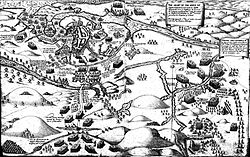
Back 1601 Abkhazian 1601 Afrikaans 1601 ALS 1601 እ.ኤ.አ. Amharic 1601 AN 1601 Arabic 1601 ARZ 1601 AST 1601 AVK 1601 Azerbaijani
| Millennium: | 2nd millennium |
|---|---|
| Centuries: | |
| Decades: | |
| Years: |

| 1601 by topic |
|---|
| Arts and science |
| Leaders |
| Birth and death categories |
| Births – Deaths |
| Establishments and disestablishments categories |
| Establishments – Disestablishments |
| Works category |
| Gregorian calendar | 1601 MDCI |
| Ab urbe condita | 2354 |
| Armenian calendar | 1050 ԹՎ ՌԾ |
| Assyrian calendar | 6351 |
| Balinese saka calendar | 1522–1523 |
| Bengali calendar | 1008 |
| Berber calendar | 2551 |
| English Regnal year | 43 Eliz. 1 – 44 Eliz. 1 |
| Buddhist calendar | 2145 |
| Burmese calendar | 963 |
| Byzantine calendar | 7109–7110 |
| Chinese calendar | 庚子年 (Metal Rat) 4298 or 4091 — to — 辛丑年 (Metal Ox) 4299 or 4092 |
| Coptic calendar | 1317–1318 |
| Discordian calendar | 2767 |
| Ethiopian calendar | 1593–1594 |
| Hebrew calendar | 5361–5362 |
| Hindu calendars | |
| - Vikram Samvat | 1657–1658 |
| - Shaka Samvat | 1522–1523 |
| - Kali Yuga | 4701–4702 |
| Holocene calendar | 11601 |
| Igbo calendar | 601–602 |
| Iranian calendar | 979–980 |
| Islamic calendar | 1009–1010 |
| Japanese calendar | Keichō 6 (慶長6年) |
| Javanese calendar | 1521–1522 |
| Julian calendar | Gregorian minus 10 days |
| Korean calendar | 3934 |
| Minguo calendar | 311 before ROC 民前311年 |
| Nanakshahi calendar | 133 |
| Thai solar calendar | 2143–2144 |
| Tibetan calendar | 阳金鼠年 (male Iron-Rat) 1727 or 1346 or 574 — to — 阴金牛年 (female Iron-Ox) 1728 or 1347 or 575 |
1601 (MDCI) was a common year starting on Monday of the Gregorian calendar and a common year starting on Thursday of the Julian calendar, the 1601st year of the Common Era (CE) and Anno Domini (AD) designations, the 601st year of the 2nd millennium, the 1st year of the 17th century, and the 2nd year of the 1600s decade. As of the start of 1601, the Gregorian calendar was 10 days ahead of the Julian calendar, which remained in localized use until 1923.
This epoch is the beginning of the 400-year Gregorian leap-year cycle within which digital files first existed; the last year of any such cycle is the only leap year whose year number is divisible by 100.
January 1 of this year (1601-01-01) is used as the base of file dates[1] and of Active Directory Logon dates[2] by Microsoft Windows. It is also the date from which ANSI dates are counted and were adopted by the American National Standards Institute for use with COBOL and other computer languages. All versions of the Microsoft Windows operating system from Windows 95 onward count units of one hundred nanoseconds from this epoch as a counter having 63 bits until 30828/9/14 02:48:05.4775807.[3] April 1 of this year is the earliest possible calendar date in Microsoft Outlook.[4]
- ^ Microsoft Windows technical note on file dates, referencing year 1601
- ^ Microsoft Windows technical note on file dates, referencing year 1601 Archived March 8, 2009, at the Wayback Machine
- ^ "Decimal Time.net".
- ^ Office-Watch.com (2019-07-23). "What's the earliest date possible in Outlook?". Office Watch. Retrieved 2024-03-13.
© MMXXIII Rich X Search. We shall prevail. All rights reserved. Rich X Search